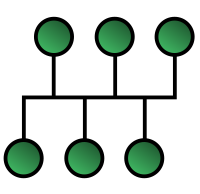Bus topology

Imagine you are going on a bus ride to your school with your friends. All of you are sitting on a straight line of seats facing forward, and you can talk to each other without turning around. This is how a bus topology works!
In a computer network, bus topology means the computers are connected in a straight line using a cable called the "bus." Each computer has a network card that allows it to communicate with other devices on the bus. Just like sitting on a bus, all computers on the bus can "talk" directly to those next to them without going through a central device, like a router or switch.
If one computer wants to send a message to another computer, it sends the message onto the bus. All the computers on the bus see that message, but only the intended recipient picks it up and reads it. All the rest ignore it.
Just like on a bus, if there's a problem with the cable, like damage or a break, all the devices on the bus can be affected. This makes bus topology less reliable than other topologies, but it's still useful for smaller networks where reliability isn't as important.
In a computer network, bus topology means the computers are connected in a straight line using a cable called the "bus." Each computer has a network card that allows it to communicate with other devices on the bus. Just like sitting on a bus, all computers on the bus can "talk" directly to those next to them without going through a central device, like a router or switch.
If one computer wants to send a message to another computer, it sends the message onto the bus. All the computers on the bus see that message, but only the intended recipient picks it up and reads it. All the rest ignore it.
Just like on a bus, if there's a problem with the cable, like damage or a break, all the devices on the bus can be affected. This makes bus topology less reliable than other topologies, but it's still useful for smaller networks where reliability isn't as important.
